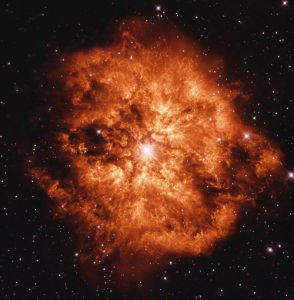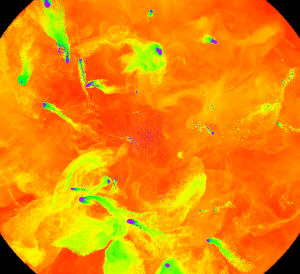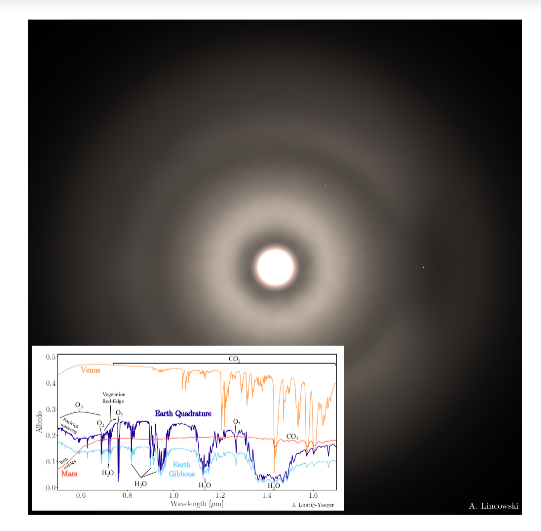Roughly half of the coursework in Pre-MAP will be spent working on a research project in a very small group with mentors from the Astronomy Department, who will usually be a graduate student and their faculty advisor. The research projects typically advance the research goals of your mentor, and so the projects that we offer cover a variety of topics and size-scales from stars to galaxies.
Students can select their top three project choices, and we will sort you into groups among your top choices. Read about the projects below, and follow the links to learn about your potential advisors.

Title: Searching for Change in All the Wrong Places
Mentors: Trevor Dorn-Wallenstein
Students: Cayenne Matt & Keyan Gootkin
Skills: UNIX, Python 3, iPython/Jupyter notebooks, acronym, astropy, matplotlib, numpy

Title: Simulating Galaxy Clusters
Mentors: Iryna Butsky
Students: Tessa Pargiter-Hatem & Julia Jansen
Skills: Python/numpy/pylab, basic unix commands
Galaxy clusters are collections of hundreds, or even thousands of galaxies that are gravitationally bound inside massive dark matter halos. They form some the largest structures in our universe and are integral to testing cosmological theories which help us understand how the universe formed and ultimately predict its fate.
The intracluster medium (ICM; the hot plasma that fills the space between galaxies in a galaxy cluster) is a unique environment, that can result in the formation of the most massive galaxies and black holes in the universe. The temperature, kinematics, and chemical composition of the the ICM is shaped by the strong outflows from galaxies inside the galaxy cluster. These winds take metals that were forged by stars and expel them to distances that are many times the radius of the galaxy. Some possible wind-driving mechanisms include radiation from young massive stars, supernova explosions, and the energetic jets from supermassive black holes. Each type of wind shapes the ICM and its host galaxy in different ways, and it is unclear which type of wind (or perhaps which combination) dominates under different conditions.
One way to answer this question is to simulate a galaxy cluster, testing different stellar feedback models. Analyzing these simulations and comparing them to existing observations provides constraints on the physical processes governing the co-evolution of the ICM and cluster galaxies.
In this project, you will be exploring data from a computer model run on one of the largest supercomputers in the country, where a patch of the Universe containing hundreds of galaxies has been simulated. You will use python-based data visualization tools to explore these galaxies, understand the nature of their outflows, and discover the correlations between observed metal abundances and the mechanisms driving galactic winds.

Title: Mapping Cosmic Baryon Cycle with Quasar Spectroscopy
Mentor: Hannah Bish, Grace Telford, & Prof. Jessica Werk
Students: Olivia Petry & Travis Mandeville
Skills: Python Notebooks (preferred; not required), basic unix commands, organization and pattern recognition skills
The atoms in your body and on this planet are continually cycling and recycling into a variety of forms and environments. The oxygen atoms in every breath we take were once breathed by ancient humans and dinosaurs alike. On an even grander scale, the atoms (aka baryons) in the Universe are cycling into and out of galaxies over billions of years. This so-called cosmic baryon cycle holds the key to understanding galaxy evolution and our own cosmic origins.
The majority of the atomic matter in the Universe lies in the diffuse, ionized, and warm-hot (T > 10^4 K) gas surrounding and in-between galaxies, aka the circumgalactic and intergalactic media. We cannot observe this gas directly by its own emission; instead we study it with a technique called Quasar Absorption Line Spectroscopy. In this method, the Quasars serve as bright background sources whose light passes through foreground intergalactic filaments and gaseous galaxy halos. The resulting absorption signatures seen in their spectra can be identified as ionized atomic transitions from Carbon, Nitrogen, Oxygen and other “heavy” elements at different redshifts that correspond to the distances of such gaseous features along the line of sight to the Quasar.
Professor Werk is conducting a large survey with the goal of understanding how this diffuse gas correlates with galaxy properties. A key part of the study requires carefully classifying all of the absorption features seen along high-resolution Quasar spectra taken with the Cosmic Origins Spectrograph (COS) on the Hubble Space Telescope (HST). We will analyze these spectra using Python tools in a graphical user interface which will enable us to identify the redshifts and measure the strengths of absorption lines from ionized elements present in the gas. By mapping the redshift distribution of many so-called `absorption line systems’, we will ultimately constrain the very elusive cosmic baryon cycle that gave rise to the visible structures in the universe.

Title: What can the JWST tell us about the Dark Matter Halos of the First Galaxies?
Mentors: Dr. Anson D’Aloisio and Prof. Matt McQuinn
Students: Eden Harris
Skills: Python, basic unix
The Universe began as an almost featureless soup of particles, consisting mostly of a new and mysterious type of matter (“dark matter”), hydrogen and helium atoms, and photons. Yet, the Universe that we observe today is far from featureless. Quite the contrary, our own Milky Way is itself embedded within a complex web of even larger structures that are teeming with other galaxies. Understanding how we, along with these larger structures, coalesced out of the primordial soup is one of the main goals of modern cosmology.
The distances across which cosmologists observe are so vast that light can take billions of years to reach us from the objects that we study. In fact, the further away we look with our telescopes, the further back in time we are able to see. The Hubble Space Telescope has given us our first glimpses of galaxies that existed when the Universe was just 400 million years old — about 3% of its current age. In little more than a year from now, Hubble’s successor — the James Webb Space Telescope (JWST) — will be launched, and it will greatly expand our view. In fact, the JWST is designed to push the frontier of observations even further than Hubble, into the epoch when we think the very first galaxies were forming. To interpret what JWST will see, cosmologists will utilize supercomputer simulations of structure formation in the Universe. In this project, students will work directly with such simulations.
According to our best model for how galaxies form, each galaxy is embedded within a more extended clump of dark matter called a “halo.” For the distant galaxies that JWST will observe, one of the hardest but most relevant quantities to measure is the masses of their halos. (Note, JWST will not be able to “see” the dark matter directly!) One of the questions that our students will seek to answer is: how might we measure the halo masses of these galaxies? In particular, students will use simulations to explore whether we can exploit the tendency of massive halos to be located near other massive halos (a property called “clustering”) to constrain their masses.

Title: Finding the Needles in the Haystack: Phase-Dependent Integrated Spectra of the Solar System Planets for Simulating Exoplanet Observations
Mentors: Andrew Lincowski, Jacob Lustig-Yaeger, Prof. Victoria Meadows
Students: Min Young Kim
Skills: Python, Linux/Unix
Potentially habitable exoplanets—those that could maintain liquid water on their surfaces—will be observed within the next few years by the James Webb Space Telescope. Beyond JWST, NASA is preparing a mission development survey that includes large diameter space telescopes that will have the capability of directly imaging exoplanets around Sun-like stars. High-resolution planetary models can be used as inputs into instrument simulators to inform development requirements. One suite of models is called “Haystacks”, which is a set of codes and data inputs that generate high-resolution spectral image cubes of the modern and Archean Solar System. When combined with instrument noise models, these cubes can be used to determine how our Solar System would appear and what information could be gathered when observed from afar. This will help set the parameters for the search for a truly Earth-like exoplanet.The “Haystacks” models include the correct Solar System dynamical architecture (i.e. the planets are in their correct 3D locations for a given date). This means each planet may be observed in a different phase—just like from Earth we see the Moon go through phases. Since exoplanets are too small to be spatially resolved, each will be observed as a single pixel, so spectra of the planetary inputs must be disk-integrated (i.e. a single spectrum for the whole planet, at a given phase).
The goal of this project is to assemble and generate phase-dependent, disk-integrated spectra for one or more Solar System planets (besides Earth) using available Solar System data, our group’s high-resolution radiative transfer code (SMART), and an integration code to calculate the disk-averaged phase. These planetary spectra will be used in a model of the Solar System to simulate exoplanet observations and inform mission planning and development for the next generation of space telescopes.
